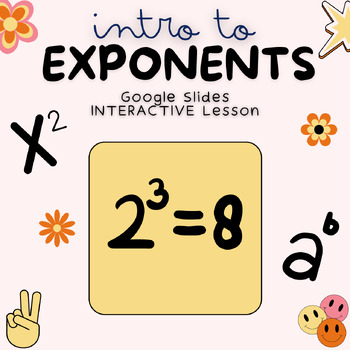Introduction to EXPONENTS
- Google Slides™

Description
This product is a 100% EDITABLE Google Slides Presentation that I use in my 5th grade classroom while tackling the first trimester of our math program! We use Envisions Math however, this is a very general lesson that INTRODUCES EXPONENTS! It serves as a wonderful first lessons to showing 5th graders what exactly exponents are, how they serve as a "Shortcut" to repeated multiplication, as well as showing what the 3 Forms of Exponents are!
**READ BELOW FOR VIRTUAL LEARNING OPTIONS!!
What's in the Google Slide Presentation:
- I always begin with a *math joke* (WARNING- they are super LAME! My kiddos always laugh at ME but it is a good way to get into math class!!!!)
- Thinking prompts. I begin with having the kids tackle a question and chat with neighbors about what they see or notice. In this presentation I show them a place value chart & simple pose the question - what do you notice? ALWAYS leads to a great discussion!
- Exponents Explanation Slide & Forms of Exponents slides. Definitions & Examples!
- How to SAY Exponents- definitions & examples!
- GUIDED PRACTICE! I have 4-5 slides of guided practice. ( I have the kiddos use whiteboards; you can also integrate any digital Add-Ons you have i.e. Nearpod!)
- Independent Practice/Exit Ticket For this specific lesson I included a link to my Independent Practice GOOGLE FORMS CHECK! You will just have to make a copy of my file and then you are free to edit & use it with your class!
- *ALSO* I have speaker comments under each slide to detail what I do in my classroom, feel free to utilize these comments or ignore & delete!
*Looking for the 2020-2021 School Year? Use this Google Slides as an upload file to NEARPOD to create a seamless live or student-paced lesson. You can also use Screencastify on top of this product and record yourself teaching the lesson. From there you can send it out or upload it to EDPUZZLE and create interactive questions throughout the lesson! The possibilities are endless!
I hope you enjoy this product! I welcome any constructive criticism you may have as well as comments about how you used it in your classroom!





